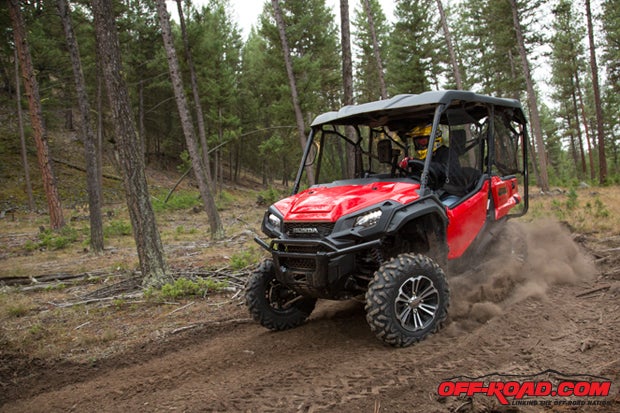
Hondaís new Pioneer 1000 is the companyís most daring, and arguably complete, side-by-side to date. Straddling the line between workhorse and fun trail machine, the Pioneer 1000 is Hondaís flagship multipurpose model headlined by an engine that features the most displacement in its class, a motorcycle-influenced transmission, and if opt for the 1000-5 it can fit up to five people.
The Pioneer 1000 clearly builds on Hondaís push into the side-by-side market in recent years, which first started with the Big Red in 2009, followed by the Pioneer 700 and 700-4 in 2013, and then entry-level Pioneer 500 in 2014. Honda is very proud of its new Pioneer 1000 and excited to put to the test against the other multipurpose machines on the market, and to commemorate its launch the company invited us out to Paws Up Resort in Montana to test drive its new creation. Without hesitation we accepted.
To put into perspective just how important this vehicle is to the company, Powersports Marketing and Communications Manager Lee Edmunds told us at the press launch that it is ďthe most important [powersports] vehicle Honda has produced in probably the last 15 years.Ē Clearly, Honda intends to take on the largest, and still growing, multipurpose side-by-side segment with its full force.
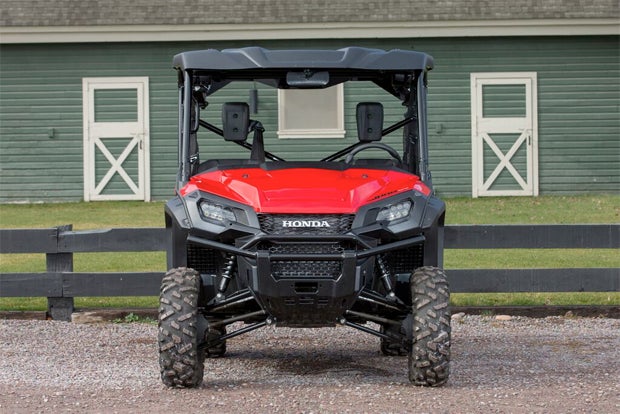
Planting the Flag
The headline for Hondaís new flagship side-by-side will certainly focus on its powerful 999cc engine, as well it should. As the multi-purpose segmentís largest displacement engine, Honda feels this purpose-built 999cc parallel twin engine will provide high-performance capability that adventurous trail riders demand while also offering the torque and pulling power needed to tackle jobs from time to time. The twin is rated to produce 72 horsepower and features a Unicam design (also found in its CRF motocross bikes) to keep the engine compact. Air is fed to the parallel twin via a 44mm throttle body.
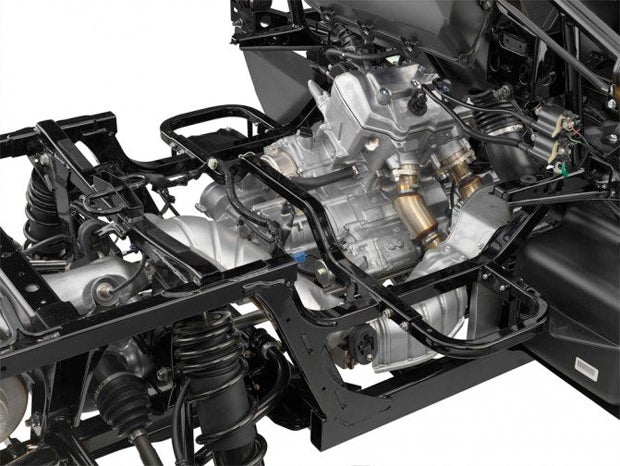
Honda employs roller rockers on the 999cc powerplant to reduce friction and wear in the engine to minimize power loss. Big Redís engineers also mounted the engine longitudinally for ideal weight distribution to eliminate right angles in the vehicleís driveline for better efficiency in delivering power to the ground. The company also rubber-mounted the engine and exhaust to the Pioneerís chassis to reduce vibration in the cabin.
The Pioneer 1000ís powerplant is powerful yet refined. Firing up the machine produces a nice rumbling growl from the exhaust, which is further pronounced when really getting on the throttle on the trail. Select Sport mode and the additional RPM will make the engine growl even louder. Yet the rubber-mounted engine and exhaust upgrades are worth noting, since seat-shake is relatively minimal whether sitting in idle, driving in slow-speed or hammering the gas pedal on the trail.
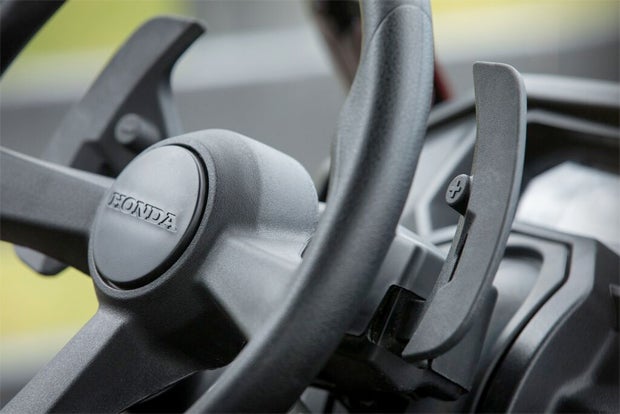
First Dual
Although the engine will garner most of the attention, Honda also made sure one of the Pioneerís most important features isnít glazed over Ė the side-by-side industryís first dual-clutch transmission (DCT). The six-speed transmission features what Honda calls ďadvanced shift logic,Ē which monitors throttle position and input, engine rpm, vehicle speed, and brake input to determine the ideal operation; that means, more relaxed driving will trigger the system to maintain the a low engine rpm, whereas more aggressive driving will trigger it maintaining a higher engine rpm.
The fully automatic dual-clutch transmission isnít simple from an engineering standpoint but it is relatively simple to explain: the DCT features one clutch for the odd-numbered gears and the other for the even-numbered gears. Essentially multiple gears are engaged at the same time, and when a shift to another gear is required one clutch disengages and the other engages, with the timing determined electronically. All of this equates to a fast-acting clutch that boasts improved efficiency with no lag time, less maintenance requirements and improved durability. Itís no wonder Honda uses DCTs in its motorcycles, and itís also used in high-performance automotive applications such as the 2017 Acura NSX. Considering the importance of reliability and durability on the trail, these are all very positive attributes for an off-road machine.
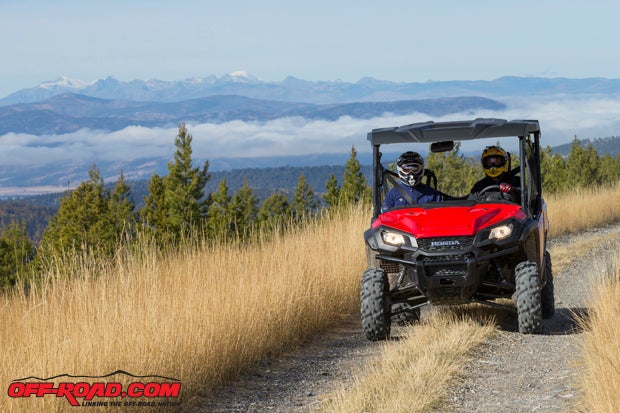
Purpose-Built Chassis
A powerful engine and motorcycle-influenced transmission mean nothing if they arenít placed in a chassis designed to handle the demands. Honda actually constructed a new purpose-built chassis for the Pioneer 1000, with both a three-person version along with a five-person 1000-5 model available. The payload capacity, which Honda tells us is measured with three full-sized adults onboard, is 1,000 pounds. For towing applications, the Pioneer 1000 is rated to pull up to 2,000 pounds.
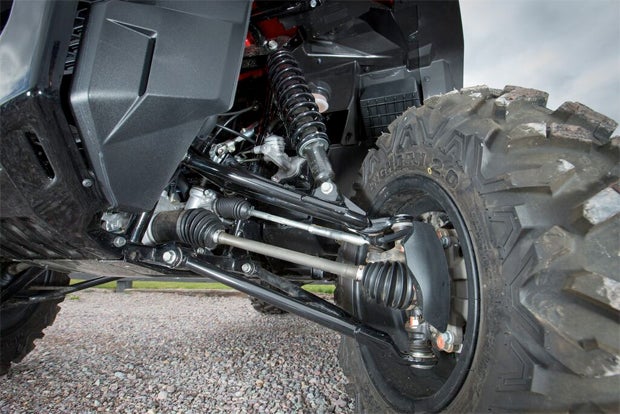
A dual A-Arm design and fully independent suspension is used front and rear on the Pioneer 1000, providing 10.5 inches of front suspension travel and 10 inches in the rear. With 27-inch tires standard on every model, Honda puts the Pioneer 1000ís ground clearance at 12.9 inches in the three-seater and 12.4 inches in 1000-5. The 1000-5 model also features a standard self-leveling rear suspension design (an option on the three-seater) that automatically maintains the ride height of the vehicle even if itís fully loaded. The 1000-5 model features QuickFlip rear seats that can convert into more bed space if needed.
Although there will be a base Pioneer 1000 available without electronic power steering (EPS), the Pioneer 1000 EPS, 1000-5 and 1000-5 Deluxe will all come standard with EPS. Aside from this feature, the 1000 EPS model will boast a few things the base model will not, such as tilt steering, sport mode, paddle shifters and color-matched door and bedside panels. Honda thoughtfully constructed its new flagship SXS with customization in mind, however, so a buyer of the Base model could potentially upgrade certain parts on their vehicle and factor that into financing before ever walking out of the door of the dealership.
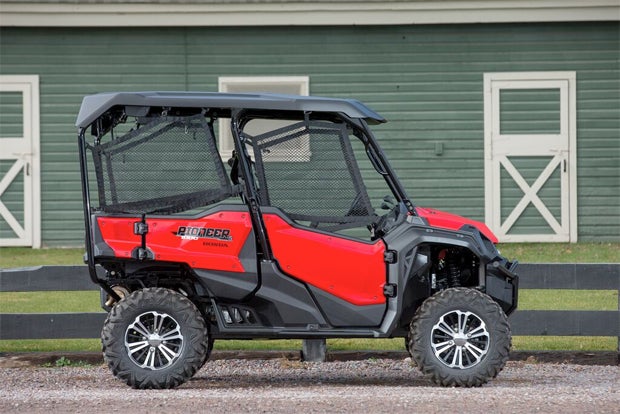
The 1000-5 model will feature just about everything found on the 1000 EPS model other than the color-matched panels, with the key difference being the addition of the QuickFlip seating to accommodate up to five riders in total. The 1000-5 also comes standard with self-leveling rear suspension. The Deluxe version of the 1000-5 will boast additional features, such as LED headlights, 14-inch aluminum wheels fitted with upgraded 27-inch Maxxis Bighorn 2.0 tires, and color-matched door and bed panels.
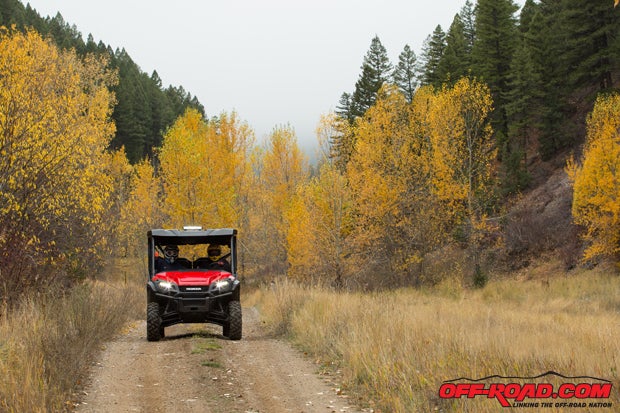
First Impressions
During Hondaís press introduction we were afforded the opportunity to explore Montana, one of the last true frontier states, on a wide variety of terrain in the Pioneer 1000. The machine features both a High range and a Low range, and in Low it features a specific low-range sub-transmission that offers a 1.42:1 ratio to double the number of available gears much like a transfer case in a 4x4 truck would. For settings, there are four options: turf mode will unlock the rear differential so it wonít tear up soft terrain; 2WD locks the rear differential while leaving the front open; 4WD locks the rear differential while putting the front diff into limited-slip mode; and offering the most traction for challenging terrain is 4WD with both the front and rear locked.
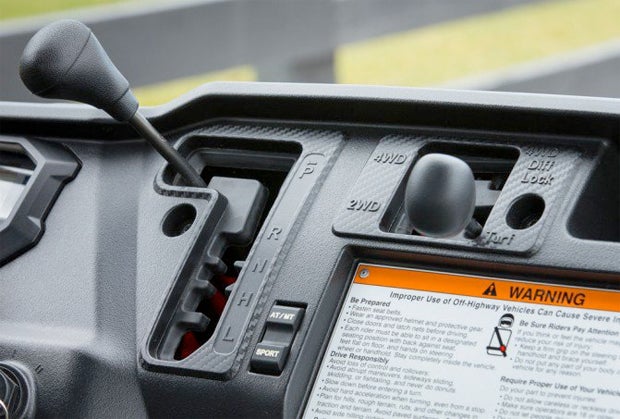
Beyond those driving modes, Honda also offers a few other settings to customize the experience. The Standard, or Automatic, setting will shuffle through the gears automatically, though it can be overridden at any point via paddle shifters mounted behind the steering wheel. Sport mode moves the shift points to a higher rpm to allow the engine to rev higher for more spirited performance driving. Finally, Manual mode allows the driver to fully control the timing of each shift via the aforementioned hand paddles.
We had a chance to check out every driving mode on the Pioneer 1000 in both the three-seater EPS and 1000-5 Deluxe (no base models were brought to Montana). As a general overview, the three-person model is a bit more playful and sporty overall, in spite of the fact that both models feature the same 80.2-inch wheelbase. The slight difference in the handling characteristics likely comes down to the additional 168 pounds of the Pioneer 1000-5 Deluxe (1709 lbs.) compared to the three-seater Pioneer 1000 EPS (1541 lbs.). That said, the five-person model didnít feel distinctly different, and we were impressed at how confidently and composed the 1000-5 felt during aggressive cornering.
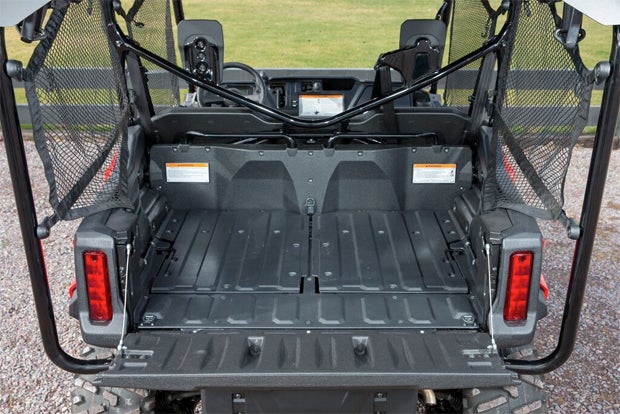
In terms of driving modes, 2WD is the most playful of the bunch if youíre looking to rally corners and break free the back end; then again, itís also not as easy to control how long the vehicle slides because traction isnít are great, so itís possible to overshoot a turn if the driver is too aggressive. The 4WD mode is a great all-around setting whether the terrain is soft, rocky or rutted, but its pairing of a locked rear differential and limited-slip front means it turns very predictably and its rear end wonít easily break free. Itís no surprise that the full-locked 4WD mode will offer the best in traction for challenging terrain. Turf Mode is best for sensitive grass areas, but itís not what you want on the trail since it doesnít grip the terrain as well. We learned this the hard way when we accidentally had this mode engaged when first starting our trail ride, noting the vehicle felt far less composed in the turns and didnít have the tight and predictable handling like the other modes.
Our second day riding the Pioneer 1000 may have been the most eye-opening experience with the machine. Honda laid out a nice loop around the Paws Up Resort property that offered much greater challenge for the 1000. A short run on access roads led us to a trail that ventured into the woods, where we were greeted with steep, 4- and 5-foot hills, with log crossings mixed in, small mud holes and even a number of tree stumps thrown into the mix. We immediately gained an appreciation for the Pioneer 1000ís ground clearance and 27-inch Maxxis tires, which kept the frame of the vehicle from hitting on the steep uphill and downhill transitions. With terrain that varied from hard-packed dirt to soft, loose mud, these are the exact conditions for which 4WD fully locked mode is designed, and we are happy to report the Honda strolled through the course with complete confidence.
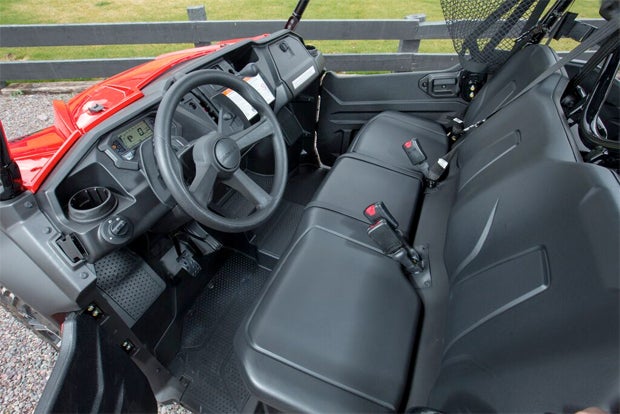
The ride was not without event either, as I had my own brain-fart moment when taking a downhill section too tight on the inside line where I clipped the passenger-side tire on a tree stump. The bad news was I bent the tie rod on that side. The good news is that the Pioneer 1000ís suspension did exactly what it was designed to do Ė the tie rod took the force of the impact and bent, leaving the rest of the suspension free of damage. Being that the tie rod is roughly a $30 replacement piece, we were happy our trail mishap didnít do any serious damage to the front end. This isnít a license to go tagging rocks and tree stumps so much as an indicator Honda did its homework in designing the front suspension.
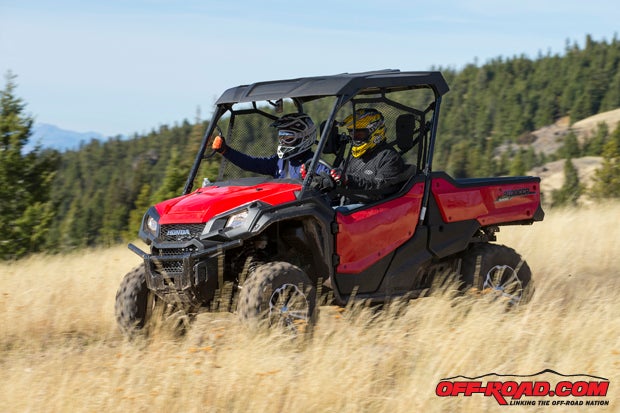
Final Thoughts
Thereís a lot to like about Hondaís Pioneer 1000. Itís a truly well balanced machine fit for a day of hard work or fun exploring the trails. Our first dayís ride covered more than 50 miles of trail outside of the Paws Up Resort on BLM land Ė quite a bit of high-speed fire roads with some occasionally tougher rock-littered sections. In this type of driving, we really enjoy using the paddle shifters to spice up the ride. That said, switching into fully automatic mode was equally fun, as the dual-clutch transmission seemed to always be in the proper gear and clicked though the gear range with calculated precision. The Sport mode is a welcome feature as well, even if the performance change isnít as noticeable as the higher revving engine would suggest.
The electronic power steering of the Pioneer 1000 impressed us as soon as we started driving as slow speeds, and that ease of maneuverability never changed even during our fast-paced trail ride or when turning around for a second photo pass. The steering is relatively effortless, and we have a hard time imagining the machine without the EPS upgrade. The dash layout has the gear selection for High, Low, Neutral and Reverse in a easy-to-reach location Ė same goes for the Sport mode toggle switch Ė and the digital instrumentation give a good at-a-glance view of drive mode, speed and gear.
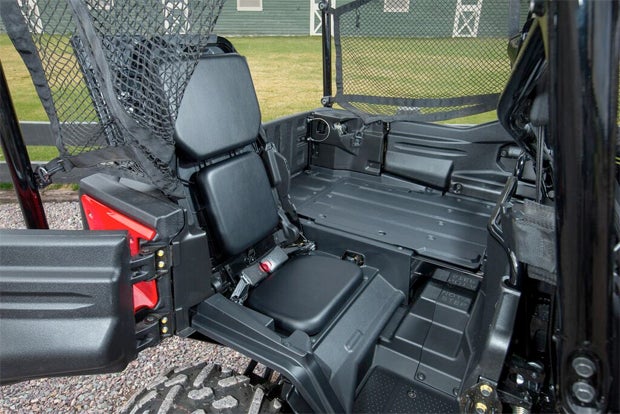
The 1000-5, starting at $17,199, is our preferred choice. It might not feel quite as nimble as the three-seater, but it still offers a fun and sporty ride, can fit up to five passengers, and we like that the rear seats fold down for added cargo space when itís time to haul gear in the bed. The front bench seat offers nice contour and a plush ride for up-front passengers. Although three adults could fit up front, weíd prefer the 1000-5 model simply because it offers the optional rear seats, and because three adults up front is a bit snug for trail riding.
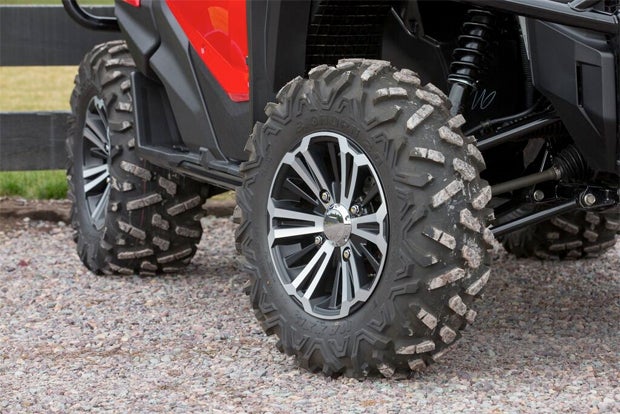
It took some time before Honda came to market with a true top-end side-by-side, but itís clear Big Red did its due diligence to make sure it was right. The Pioneer 1000 faces plenty of competition in the multipurpose segment, but the all-around versatility and performance of the Pioneer 1000 highlights the very reasons people purchase side-by-sides in the first place Ė itís a vehicle that can do a little bit of everything, and it does everything well.


 Your Privacy Choices
Your Privacy Choices